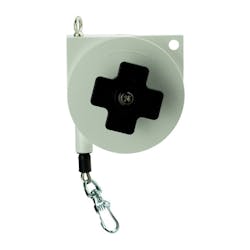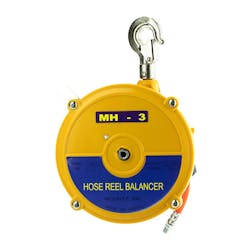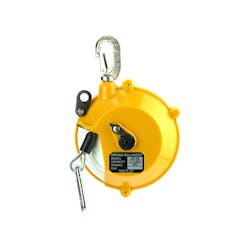If you’ve done a day of work, you know that even a light tool can get real heavy after a couple hours on the line. Which is no big deal, usually; it’s just part of the job. A week or a month will go by, you’ll get stronger, and using your tool won’t feel like you’re trying to lift Thor’s hammer every time you take a stroke or tighten a fastener. You can do anything for three months, right?
Sure. But how about for three years? Or thirty years? Over time, the repeated motion of lifting a tool and bringing it down, day in and day out, will take its toll on a tool operator’s muscles, nerves, blood vessels, ligaments, and tendons. It doesn’t matter how strong or tough your operators are; the same repeated application of small amounts of force is enough to carve canyons and turn mountains to sand. That’s more than even the burliest person can handle.
Fortunately, there is an easy fix. You don’t have to provide lighter tools for your operators or limit the hours they spend working. You just have to take the load off their shoulders. A simple tool balancer, positioned above your operator’s workstation, will carry the weight of your tool so your operator doesn’t have to. Here’s a guide to picking the right tool balancer to improve your operator’s ergonomics.
The Importance of Improving Your Operator’s Ergonomics
Ergonomics—you’ve likely heard the buzz around this word. According to the U.S. National Library of Medicine, it’s the study of the types of work people do, the tools they use, and the environments they work in. It’s a practical, applied science, pursued with the aim of reducing workplace injuries.
One of ergonomics’ basic practices is to “fit the job to the person,” or provide workplace accommodations that allow workers to perform their functions without risk of injury. Among the most common workplace injuries are musculoskeletal disorders caused by repetitive motion. According to the Bureau of Labor Statistics, in 2013, musculoskeletal disorders represented 33% of all worker injury and illness cases.
Ergonomics are of particular concern for operators working in manufacturing assembly, as they are often tasked with performing the same repetitive motions. For instance, an operator may tighten the same fastener or sequence of fasteners on a hundred, a thousand, ten thousand, or more products as they come down the line.
It doesn’t matter how much you bench—if you lift even a 10-lb. weight 10,000 times, it will take its toll. Assembly tools, such as pneumatic, pulse, and electric screwdrivers are useful versions of 10-lb. weights. Some are even heavier. Without support, employees tasked with operating these tools over time will be increasingly likely to be injured. Fortunately, these injuries can be prevented with the addition of a quality tool balancer.
Tool Balancers Reduce Injuries and Improve Performance
Tool balancers reduce the risk of musculoskeletal injuries in tool operators. This simple mechanism is suspended above your operator’s workstation and attached to their tool via a retractable cable. The cable holds the weight of the tool, meaning your operator only has to direct its movement, not support its mass.
Not only does a tool balancer reduce the risk of injury, but it also reduces fatigue and increases productivity. Without needing to support the weight of their tool for hours on end, operators are less likely to succumb to muscular fatigue, keeping their motions efficient and precise while their heads stay clear. Ready, rested workers are able to work faster, smarter, and harder than tired, worn-out operators, which spells improved worker satisfaction and increased efficiency all around.
Types of Tool Balancers
Not every tool is the same, so to effectively improve ergonomics with each of your different tools, you’ll need different tool balancers. Here’s a rundown of the common types of tool balancers available:Retractor Tool Balancers
Simplicity, simplicity. Retractable tool balancers are exactly what they sound like. At rest, your tool hangs slightly below the head of the balancer. When the operator wants to use it, they pull down to unwind the cable inside and bring the tool to bear. The cable is under continuous pressure from an internal spring, so when the operator lets go, the tool will return automatically to its rest position.
These tool balancers are the most basic option and are the most common type of balancer used in manufacturing settings. While less expensive than more specialty balancers, these balancers are limited by the amount of weight they can hold, which is about 10 lb.
Also, the internal spring does apply some upward pressure on the tool. This pressure can be adjusted and is much less severe for your operator to contend with than the weight of the tool itself. Nonetheless, this upward tension does put some small strain on your operator’s arm and shoulder.
Hose Reel Tool Balancers
Hose reel tool balancers are the refined cousin of the simple retractor balancer. They hold the same weight and operate on the same principle, using an internal spring. Where they improve on the basic retractor is the incorporation of a pneumatic hose as a support cable.
As pneumatic hoses are essential components of all air tools, this balancer does two jobs at once: protecting your operator from repetitive motion injuries and keeping their workstation clear of a trailing, pressurized hose. This helps reduce the likelihood of trips and falls, as well as punctured air hoses and their associated hazards.
Zero Gravity Tool Balancers
Zero gravity tool balancers are the head of the tool balancer family. They’re able to support far more weight than retractor or hose reel balancers, up to 264 lb. instead of 10. If you need to suspend a heavy-duty tool—and the heavier your tool is, the more you’ll want to suspend it—then a zero-gravity balancer is a smart choice.
Zero gravity balancers can support this extra weight because they do not rely on an internal spring. This also means they apply no upward pressure on the tool in your operator’s hand. When released, the tool remains in the same position. So, these balancers are even gentler on your operators than retractor balancers. When using a tool with a zero-gravity balancer, the only thing your operator has to lift is their own arm. While these balancers are more expensive than other versions, they are indispensable for heavy tools, and the price can be justified by the added protection they offer your workers.
The right tool balancer for your assembly depends on the specific tools you’re working with, so take the time to determine the best balancer for your operation. It’s definitely worth it, as installing tool balancers in your workplace is a simple, inexpensive way to reduce operator injury from repetitive motion. Workplace injuries are costly and result in lost productivity. As such, adding tool balancers is an investment that will pay for itself at the same time that it protects your employees.













